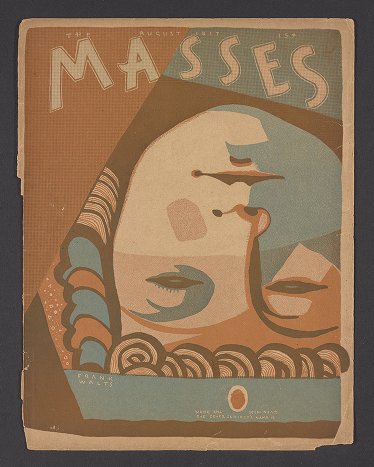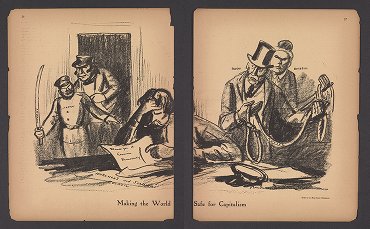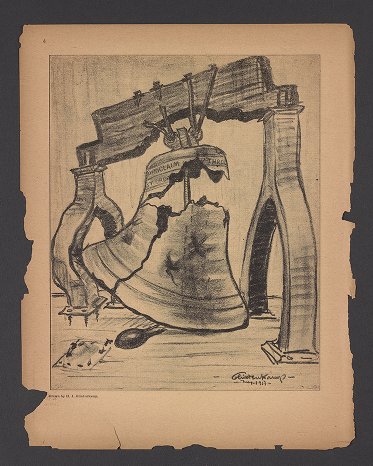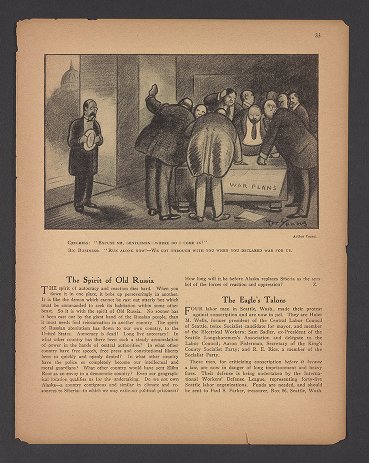 From January 1911 to December 1917, the Socialist monthly, The Masses, published articles, essays, and cartoons commenting on American political conservativism. Its artists included some of the leading American painters and printmakers of the era. “For the Masses, beauty and the revolution were the same thing, or rather parts of the same thing. The Revolution was beautiful and beauty was revolutionary.”–William L. O’Neill
From January 1911 to December 1917, the Socialist monthly, The Masses, published articles, essays, and cartoons commenting on American political conservativism. Its artists included some of the leading American painters and printmakers of the era. “For the Masses, beauty and the revolution were the same thing, or rather parts of the same thing. The Revolution was beautiful and beauty was revolutionary.”–William L. O’Neill
On June 15, 1917, two months after America’s entrance into World War I, the United States Congress passed the Espionage Act. Enforced largely by A. Mitchell Palmer, the United States attorney general under President Woodrow Wilson, “the Espionage Act essentially made it a crime for any person to convey information intended to interfere with the U.S. armed forces prosecution of the war effort or to promote the success of the country’s enemies.”
The following month, the Espionage Act was enforced for the first time when the U.S. Post Office banned The Masses from mailing their August issue citing anti-war cartoons and poems. While many issues contained radical ideas over the years, four plates in the August issue were said to violate the Act specifically:
 Boardman Robinson’s “Making the World Safe for Capitalism”
Boardman Robinson’s “Making the World Safe for Capitalism”
 H.J. Glintenkamp’s “Conscription”
H.J. Glintenkamp’s “Conscription”
 H.J. Glintenkamp’s untitled drawing known as The Liberty Bell.
H.J. Glintenkamp’s untitled drawing known as The Liberty Bell.
The U.S. District Court overturned the ban on July 24, 1917, but the Court of Appeals upheld the government’s ban on November 2, 1917. The final trial in 1918 ended in a hung jury. http://todayinclh.com/?event=hung-jury-the-masses-editors-not-convicted
Geoffrey R. Stone, an American law professor and noted First Amendment scholar, elaborated on the prosecution of The Masses:
“In the summer of 1917, Postmaster General Burleson ordered the August issue of The Masses to be excluded from the mail, exercising his authority under the Espionage Act of 1917. The Masses sought an injunction to forbid the local postmaster from refusing to accept the August issue for mailing. The postmaster argued that four cartoons and four pieces of text violated the Act, thus justifying the order of exclusion.”
“The postmaster argued that the cartoons and text violated section 3 of the Espionage Act, in that they willfully caused or attempted ‘to cause insubordination, disloyalty, mutiny or refusal of duty in the military or naval forces’ and obstructed ‘the recruiting or enlistment service of the United States.’”
“…Judge Learned Hand conceded the postmaster’s claim that ‘to arouse discontent and disaffection among the people with the prosecution of the war and with the draft tends to promote a mutinous and insubordinate temper among the troops.’ But he argued that to read to word ‘cause’ so ‘broadly would … involve necessarily as a consequence the suppression of all hostile criticism, and of all opinion except what encouraged and supported the existing policies.’”
–Geoffrey R. Stone, “Judge Learned Hand and the Espionage Act of 1917: A Mystery Unraveled,” University of Chicago Law Review 335 (2003).
Echoes of Revolt: The Masses, 1911-1917 (Chicago, Quadrangle Books [1966]). Recap Oversize HX1 .M21q
Caricature of artists from Art Young (1866-1943), On my way: being the book of Art Young in text and picture (New York: H. Liveright, 1928). Graphic Arts Collection (GAX) NE910.U5 Y8 1928
The Masses (New York: Masses Pub. Co., 1911-1917). Recap Oversize HX1 .M2q


